Interpreting Daly’s Sustainability Criteria for Assessing the Sustainability of Marine Protected Areas: A System Dynamics Approach
Abstract
:1. Introduction
2. Materials and Methods
2.1. Study Site
2.2. Causal Loop Diagram (CLD)
2.3. System Dynamics Modelling
- Problem identification: identify and articulate the problem to be dealt with;
- Model conceptualization: develop a causal theory about the problem;
- Model formulation: formulate an SD simulation model of the causal theory;
- Model testing: test the model to assess whether it is fit for the purpose; and
- Model use, quite often model-based policy analysis: use the model to design and evaluate structural policies to address the problem.
- n = number of observation (t = 1, 2, …, n);
- St = simulated value at t;
- At = actual value at t.
- and = the mean of simulated and actual value;sS and sA = the standard deviation of simulated and actual value;
- (correlation coefficient between simulated and actual value).
- UM, US, and UC = the fraction of MSE due to bias, unequal variance, and unequal covariance, respectively.
2.4. Sustainability Assessment
3. Results
3.1. Causal Loop Diagram
3.2. System Dynamics Modelling
3.2.1. Fish Population Dynamics
- B = fish population;
- r = fish growth rate;
- K = fish stock carrying capacity;
- X = fishing effort;
- q = fraction of fish biomass caught by each effort.
= qBt + rqBt − rqBt2/K − q2BtXt
= (1 + r) qBt − rq2Bt2/qK − q2BtXt
= (1 + r) qBt − (r/qK) (qBt)2 – qXt (qBt).
3.2.2. Coral Reef Coverage Dynamics
3.2.3. Tourism-Pollution Dynamics
3.2.4. Sensitivity Analysis
4. Discussion
4.1. Sustainability Assessment
4.2. Management Implications
4.2.1. Lowering Total Allowable Catch
4.2.2. Coral Transplantation
4.2.3. Better Waste Management
5. Conclusions
Author Contributions
Funding
Acknowledgments
Conflicts of Interest
Appendix A
| Variable/Parameter | Unit | Value/Equation | |
|---|---|---|---|
| Fish population | Fish population | biomass | INTEG (fish growth − catch, initial value = 21,384.5) |
| Fish growth | biomass | fish regeneration rate × fish population × (1−(Fish population/carrying capacity for fish)) | |
| carrying capacity of fish | biomass | 306,414 | |
| fish regeneration rate | Dmnl | WITH LOOKUP (water quality, ([(0,0)−(100,10)],(0,0.5),(13.1498,0.614035),(25,0.9),(38.2263,0.921053),(50,1),(63.3028,1.00877),(75,1.1),(87.4618,1.18421),(100,1.2))) | |
| Fishing catch | ton | Efficiency × Number of fishing gears × Fish population | |
| catch efficiency | Dmnl | 0.0001 | |
| Number of fishing gears | units | INTEG (change in number of fishing gears, initial value = 6962) | |
| Change in number of fishing gears | units | Gap × fractional change rate of fishing gears × Number of fishing gears | |
| fractional change rate of fishing gears | Dmnl | −0.209 | |
| total allowable catch | ton | 90,000 | |
| gap | ton | IF THEN ELSE((total allowable catch−catch>=0), −0.15, 1.1) | |
| effect of fish on tourism | Dmnl | ((max fish − min fish) × (1 − EXP(normal slope fish × ((Fish population/306414) − inflection fish))/(1 + EXP (normal slope fish × ((Fish population/306414) − inflection fish)))) + min fish) | |
| normal slope effect of fish | Dmnl | 1.5 | |
| inflection effect of fish | Dmnl | 2 | |
| min effect of fish | Dmnl | 1 | |
| max effect of fish | Dmnl | 5 | |
| Coral reef | Coral | hectare | INTEG (coral recruitment-coral decayed, initial value = 318) |
| Coral recruitment | hectare | (coral recruitment rate + (coral growth rate × Coral/carrying capacity for coral and macroalgae)) × unoccupied space | |
| coral recruitment rate | Dmnl | 0.01 | |
| coral growth rate | Dmnl | 0.2 | |
| carrying capacity of coral and macroalgae | hectare | 1818.60 | |
| unoccupied space | hectare | carrying capacity for coral and macroalgae-Coral-Macroalgae | |
| Coral decayed | hectare | (coral decay rate × Coral × coral bleaching)+(coral decay rate × Coral) | |
| coral decay rate | Dmnl | WITH LOOKUP (water quality, ([(0,0)−(100,0.1)],(0,0.04),(11.6208,0.0368421),(24.159,0.0333333),(37.0031,0.0311403),(48.9297,0.0285088),(62.3853,0.025),(74.9235,0.0223684),(88.9908,0.0201754),(100,0.02) )) | |
| coral bleaching | hectare | 10 × PULSE(2015, 1) | |
| coral reef coverage | percent | Coral/carrying capacity for coral and macroalgae × 100 | |
| Macroalgae | hectare | INTEG (change in macroalgae, initial value = 320) | |
| Change in macroalgae | hectare | macroalgae growth rate × (Macroalgae/carrying capacity for coral and macroalgae) × unoccupied space-(grazing rate × Macroalgae) | |
| macroalgae growth rate | Dmnl | 0.3 | |
| grazing rate | Dmnl | WITH LOOKUP ((Fish population/306414), ([(0,0)−(1,0.1)],(0,0),(0.25,0.008),(0.5,0.0095),(0.75,0.0097),(1,0.01))) | |
| effect of coral on tourism | Dmnl | ((max coral − min coral) × (1 − EXP(normal slope coral × ((Coral/1818.6) − inflection coral))/(1 + EXP(normal slope coral × ((Coral/1818.6) − inflection coral)))) + min coral) | |
| normal slope effect of coral | Dmnl | 1.5 | |
| inflection effect of coral | Dmnl | 2 | |
| min effect of coral | Dmnl | 1 | |
| max effect of coral | Dmnl | 5 | |
| Tourism | Number of tourists | individuals | INTEG (change in number of tourists, initial value = 10,000) |
| Change in number of tourists | individuals | Number of tourists × marine park visiting rate × (1 − (Number of tourists/carrying capacity of tourist) + (tourism attractiveness × Number of tourists/carrying capacity of tourist)) | |
| carrying capacity of tourist | individuals | 85,775 | |
| tourism growth rate | Dmnl | 0.11 | |
| tourism attractiveness | Dmnl | effect of coral on tourism + effect of fish on tourism+effect of pollution on tourism + effect of tourists on tourism | |
| effect of tourists on tourism | Dmnl | (max tourist − min tourist) × (1 − EXP(normal slope tourist × ((Number of tourists/42,500) − inflection tourist))/(1 + EXP(normal slope tourist × ((Number of tourists/42,500)−inflection tourist))) + min tourist) | |
| normal slope effect of tourists | Dmnl | 1.5 | |
| inflection effect of tourists | Dmnl | 4 | |
| min effect of tourists | Dmnl | −30 | |
| max effect of tourist | Dmnl | 10 | |
| Pollution | Number of residents | individuals | INTEG (birth-death, initial value = 370,489) |
| Birth | individuals | birth rate × Number of residents | |
| birth rate | Dmnl | 0.0162 | |
| Death | individuals | death rate × Number of residents | |
| death rate | Dmnl | 0.0065 | |
| Waste | units | INTEG (waste loading-waste treatment-waste polluting environment, initial value = 40,000) | |
| Waste loading | units | (Number of tourists × waste discharge rate of tourist) + (Number of residents × waste discharge rate of resident) | |
| waste discharge rate of resident | Dmnl | 0.11 | |
| waste discharge rate of tourist | Dmnl | 0.03 | |
| Waste treatment | units | fraction of waste treatment × Waste | |
| fraction of waste treatment | Dmnl | 0.2 | |
| Waste polluting environment | units | fraction of waste polluting × Waste | |
| fraction of waste polluting | Dmnl | 0.8 | |
| Pollution | units | INTEG (polluting environment-pollution treatment, initial value = 39,000) | |
| pollution treatment | Dmnl | fraction of pollution treatment × Pollution | |
| fraction of pollution treatment | Dmnl | 0.25 | |
| effect of pollution on tourism | Dmnl | ((max pollution − min pollution) × (1 − EXP(normal slope pollution × ((Pollution/200,000) − inflection pollution))/(1 + EXP(normal slope pollution × ((Pollution/200,000) − inflection pollution)))) + min pollution) | |
| normal slope effect of pollution | Dmnl | 1.5 | |
| inflection effect of pollution | Dmnl | 4 | |
| min effect of pollution | Dmnl | −40 | |
| max effect of pollution | Dmnl | 0 | |
| water quality | Dmnl | 100+effect of pollution on water quality | |
| effect of pollution on water quality | Dmnl | ((max wq − min wq) × (1 − EXP(normal slope wq) × ((Pollution/200,000) − inflection wq))/(1 + EXP(normal slope wq × ((Pollution/200,000) − inflection wq)))) + min wq) | |
| normal slope effect of water quality | Dmnl | 1.5 | |
| inflection effect of water quality | Dmnl | 4 | |
| min effect of water quality | Dmnl | −100 | |
| max effect of water quality | Dmnl | 0 |
References
- IUCN. Establishing Resilient Marine Protected Area Networks—Making It Happen; National Oceanic and Atmospheric Administration and The Nature Conservancy: Washington, DC, USA, 2008.
- FAO. The State of World Fisheries and Aquaculture; FAO: Rome, Italy, 2016. [Google Scholar]
- FAO. Marine Protected Areas as a Tool for Fisheries Management. About MPAs. 2009, pp. 1–14. Available online: https://www.imr.no/filarkiv/kopi_av_filarkiv/2006/11/Carl_Gustav_Lundin-IUCNs_work_on_MPAs.pdf/en (accessed on 20 August 2019).
- WCPA/IUCN. Establishing Marine Protected Area Networks. Making It Happen. A Guide for Developing National and Regional Capacity for Building MPA Networks; National Oceanic and Atmospheric Administration and The Nature Conservancy: Washington, DC, USA, 2007.
- United Nations. Transforming our world: The 2030 Agenda for Sustainable Development. 2015, pp. 1–35. Available online: https://sustainabledevelopment.un.org/content/documents/21252030%20Agenda%20for%20Sustainable%20Development%20web.pdf (accessed on 20 August 2019).
- Xu, E.G.B.; Leung, K.M.Y.; Morton, B.; Lee, J.H.W. Science of the Total Environment An integrated environmental risk assessment and management framework for enhancing the sustainability of marine protected areas: The Cape d ’ Aguilar Marine Reserve case study in Hong Kong. Sci. Total Environ. 2015, 505, 269–281. [Google Scholar] [CrossRef]
- Pomeroy, R.S.; Watson, L.M.; Parks, J.E.; Cid, G.A. How is your MPA doing? A methodology for evaluating the management effectiveness of marine protected areas. Ocean Coast. Manag. 2005, 48, 485–502. [Google Scholar] [CrossRef]
- Arceo, P.; Granados-Barba, A. Evaluating sustainability criteria for a marine protected area in Veracruz, Mexico. Ocean Coast. Manag. 2010, 53, 535–543. [Google Scholar] [CrossRef]
- Marques, A.S.; Ramos, T.B.; Caeiro, S.; Costa, M.H. Adaptive-participative sustainability indicators in marine protected areas: Design and communication. Ocean Coast. Manag. 2013, 72, 36–45. [Google Scholar] [CrossRef]
- Ohl, C.; Krauze, K.; Grunbuhel, C. Towards an understanding of long-term ecosystem dynamics by merging socio-economic and environmental research. Ecol. Econ. 2007, 63, 383–391. [Google Scholar] [CrossRef]
- Mohamad, D.; Rahman, S.; Bahauddin, A.; Mohamed, B. Tourism sea activities that cause damages towards coral reefs in Sembilan Islands. Tour. Leis. Glob. Chang. 2014, 1, 112–123. [Google Scholar]
- Mangi, S.; Roberts, C. Quantifying the environmental impacts of artisanal fishing gear on Kenya’s coral reef ecosystems. Mar. Pollut. Bull. 2006, 52, 1646–1660. [Google Scholar] [CrossRef]
- Keeble, B.R. Brutland Report: Our Common Future. Med. War 1988, 4, 17–25. [Google Scholar] [CrossRef]
- Daly, H. Ecological Economics and Sustainable Development Selected Essays of Herman Daly; Edward Elgar Publishing: Cheltenham, UK, 2007. [Google Scholar]
- Collins, R.D. Using inclusive wealth for dynamic analyses of sustainable development: Theory, reflection and application. In Proceedings of the 32nd International Conference of the System Dynamics Society, Delft, The Netherlands, 20–24 July 2014; pp. 1–21. Available online: https://www.systemdynamics.org/assets/conferences/2014/proceed/papers/P1207.pdf (accessed on 8 August 2019).
- Sterman, J. Business Dynamics: Systems Thinking and Modeling for a Complex World. Review 2000, 34, 324–326. [Google Scholar]
- Homer, J.; Oliva, R. Maps and models in system dynamics: A response to Coyle. Syst. Dyn. Rev. 2001, 17, 347–355. [Google Scholar] [CrossRef]
- Lane, D.C. Diagramming Conventions in System Dynamics. J. Oper. Res. Soc. 2000, 51, 241. [Google Scholar] [CrossRef]
- Pruyt, E. Small System Dynamics Models for Big Issues: Triple Jump towards Real-World Complexity, 1st ed.; TU Delft Library: Delft, The Netherlands, 2013. [Google Scholar]
- Lopes, R.; Videira, N. Modelling feedback processes underpinning management of ecosystem services: The role of participatory systems mapping. Ecosyst. Serv. 2017, 28, 28–42. [Google Scholar] [CrossRef]
- Akhtar, M.K. A System Dynamics Based Integrated Assessment Modelling of Global-Regional Climate Change: A Model for Analyzing the Behaviour of the Social-Energy-Economy; University of Western Ontario: London, ON, Canada, 2011; p. 352. [Google Scholar]
- Sterman, J. Sustaining Sustainability: Creating a Systems Science in a Fragmented Academy and Polarized World. In Sustainability Science: The Emerging Paradigm and the Urban Environment; Weinstein, M., Turner, R., Eds.; Springer Science: New York, NY, USA, 2012; pp. 21–58. [Google Scholar]
- Dudley, R.G. A basis for understanding fishery management dynamics. Syst. Dyn. Rev. 2008, 24, 1–29. [Google Scholar] [CrossRef]
- Chang, Y.; Hong, F.; Lee, M. A system dynamic based DSS for sustainable coral reef management in Kenting coastal zone, Taiwan. Ecol. Model. 2008, 211, 153–168. [Google Scholar] [CrossRef]
- Tan, W.J.; Yang, C.F.; Château, P.A.; Lee, M.T.; Chang, Y.C. Integrated coastal-zone management for sustainable tourism using a decision support system based on system dynamics: A case study of Cijin, Kaohsiung, Taiwan. Ocean Coast. Manag. 2018, 153, 131–139. [Google Scholar] [CrossRef]
- Melbourne-Thomas, J.; Johnson, C.R.; Fung, T.; Seymour, R.M.; Chérubin, L.M.; Arias-González, J.E.; Fulton, E.A. Regional-scale scenario modeling for coral reefs: A decision support tool to inform management of a complex system. Ecol. Appl. 2011, 21, 1380–1398. [Google Scholar] [CrossRef]
- Van De Leemput, I.A.; Hughes, T.P.; Van Nes, E.H.; Scheffer, M. Multiple feedbacks and the prevalence of alternate stable states on coral reefs. Coral Reefs 2016, 35, 857–865. [Google Scholar] [CrossRef]
- Holmes, G.; Johnstone, R. Modelling coral reef ecosystems with limited observational data. Ecol. Model. 2010, 221, 1173–1183. [Google Scholar] [CrossRef]
- Sealey, S.; Cushion, N. Efforts, resources and costs required for long term environmental management of a resort development: The case of Baker’s Bay Golf and Ocean Club, The Bahamas. J. Sustain. Tour. 2009, 17, 375–395. [Google Scholar] [CrossRef]
- Mateu-Sbert, J.; Ricci-Cabello, I.; Villalonga-Olives, E.; Cabeza-Irigoyen, E. The impact of tourism on municipal solid waste generation: The case of Menorca Island (Spain). Waste Manag. 2013, 33, 2589–2593. [Google Scholar] [CrossRef]
- Kapmeier, F.; Gonçalves, P. Wasted paradise? Policies for Small Island States to manage tourism-driven growth while controlling waste generation: The case of the Maldives. Syst. Dyn. Rev. 2018, 34, 172–221. [Google Scholar] [CrossRef]
- Trihadiningrum, Y. Evaluasi Kapasitas Lahan Tpa Ladang Laweh Di Kabupaten Padang Pariaman Menuju Penerapan Sistem Controlled Landfill. Indones. J. Urban Environ. Technol. 2018, 1, 124–136. [Google Scholar]
- Romeiro, A.R. Sustainable development: An ecological economics perspective. Estud. Avançados 2012, 26, 65–92. [Google Scholar] [CrossRef]
- Neumann, B.; Ott, K.; Kenchington, R. Strong sustainability in coastal areas: A conceptual interpretation of SDG 14. Sustain. Sci. 2017, 12, 1019–1035. [Google Scholar] [CrossRef]
- Halpern, B.; Warner, R. Marine reserves have rapid and lasting effects. Halpern & Wame. Ecol. Lett. 2002, 5, 361–366. [Google Scholar]
- Hilborn, R.; Micheli, F.; de Leo, G.A. Integrating marine protected areas with catch regulation. Can. J. Fish. Aquat. Sci. 2006, 63, 642–649. [Google Scholar] [CrossRef]
- Gouezo, M.; Golbuu, Y.; Fabricius, K.; Olsudong, D.; Mereb, G.; Nestor, V.; Doropoulos, C. Drivers of recovery and reassembly of coral reef communities. Proc. R. Soc. B 2019, 286, 20182908. [Google Scholar] [CrossRef] [Green Version]
- Bowden-kerby, A. Coral Transplantation and Restocking to Accelerate the Recovery of Coral Reef Habitats and Fisheries Resources within No-Take Marine Protected Areas: Hands-On Approaches To Support Community-Based Coral Reef Management. In Proceedings of the Second International Tropical Marine Ecosystems Management Symposium (ITMEMS 2), Manilla, Philippines, 24–27 March 2003; p. 15. [Google Scholar]
- Bowden-kerby, A. Low-tech Coral Reef Restoration Methods Modeled after Natural Fragmentation Processes. Bull. Mar. Sci. 2001, 69, 915–931. [Google Scholar]
- Karkkainen, B.C. Collaborative ecosystem governance: Scale, complexity, and dynamism. Va. Environ. Law J. 2002, 21, 189–243. [Google Scholar]
- Jentoft, S.; Chuenpagdee, R. Fisheries and coastal governance as a wicked problem. Mar. Policy 2009, 33, 553–560. [Google Scholar] [CrossRef]
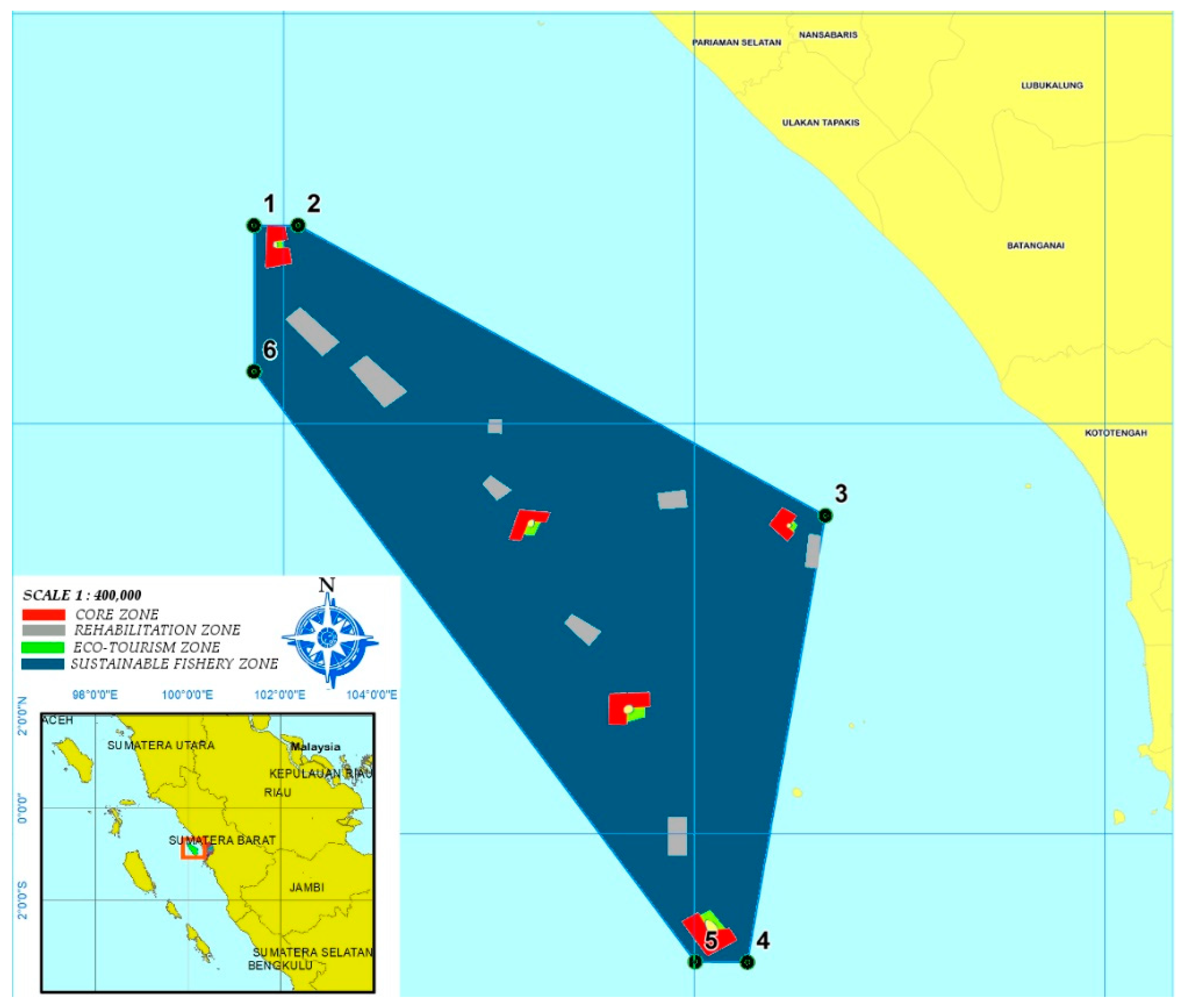
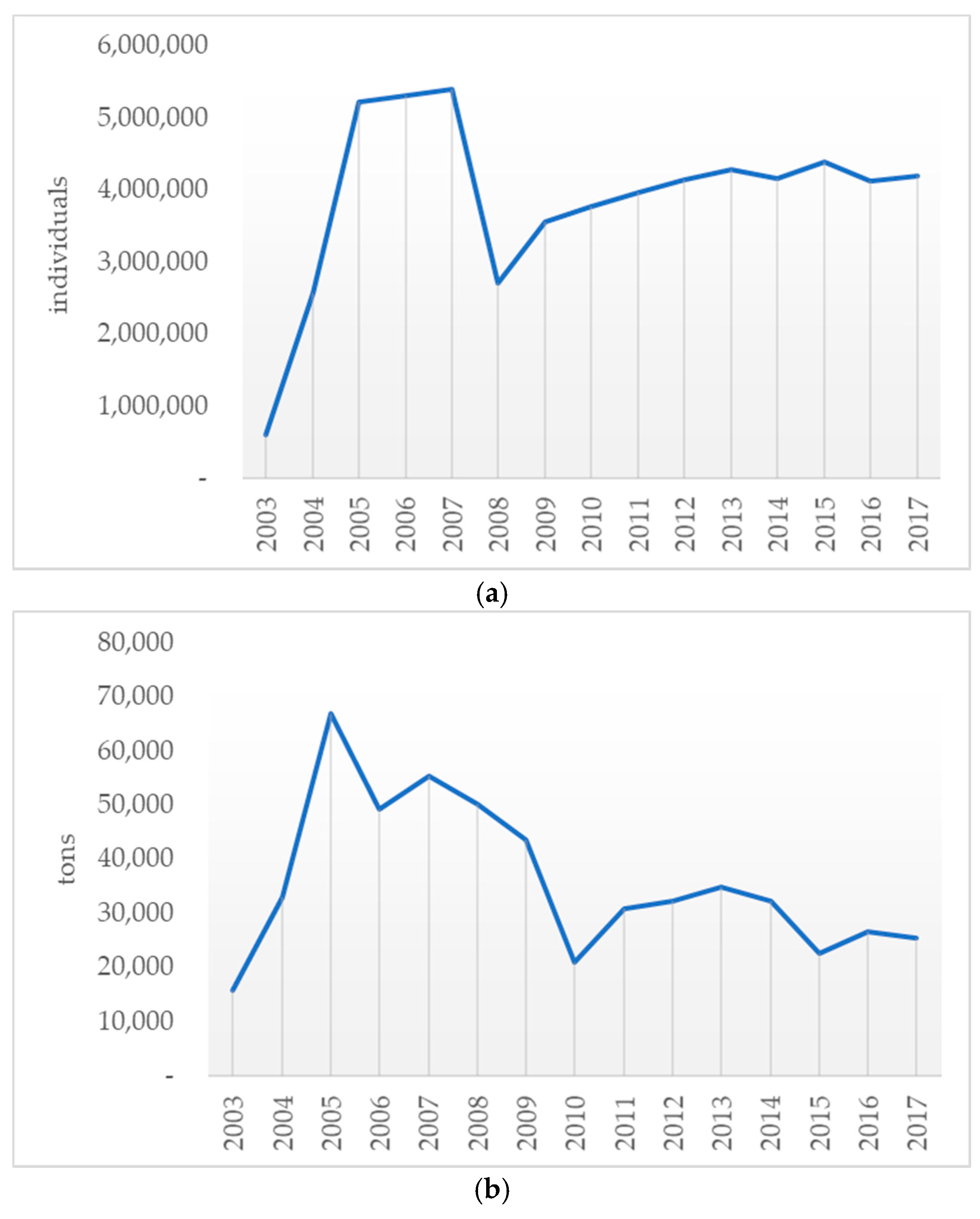



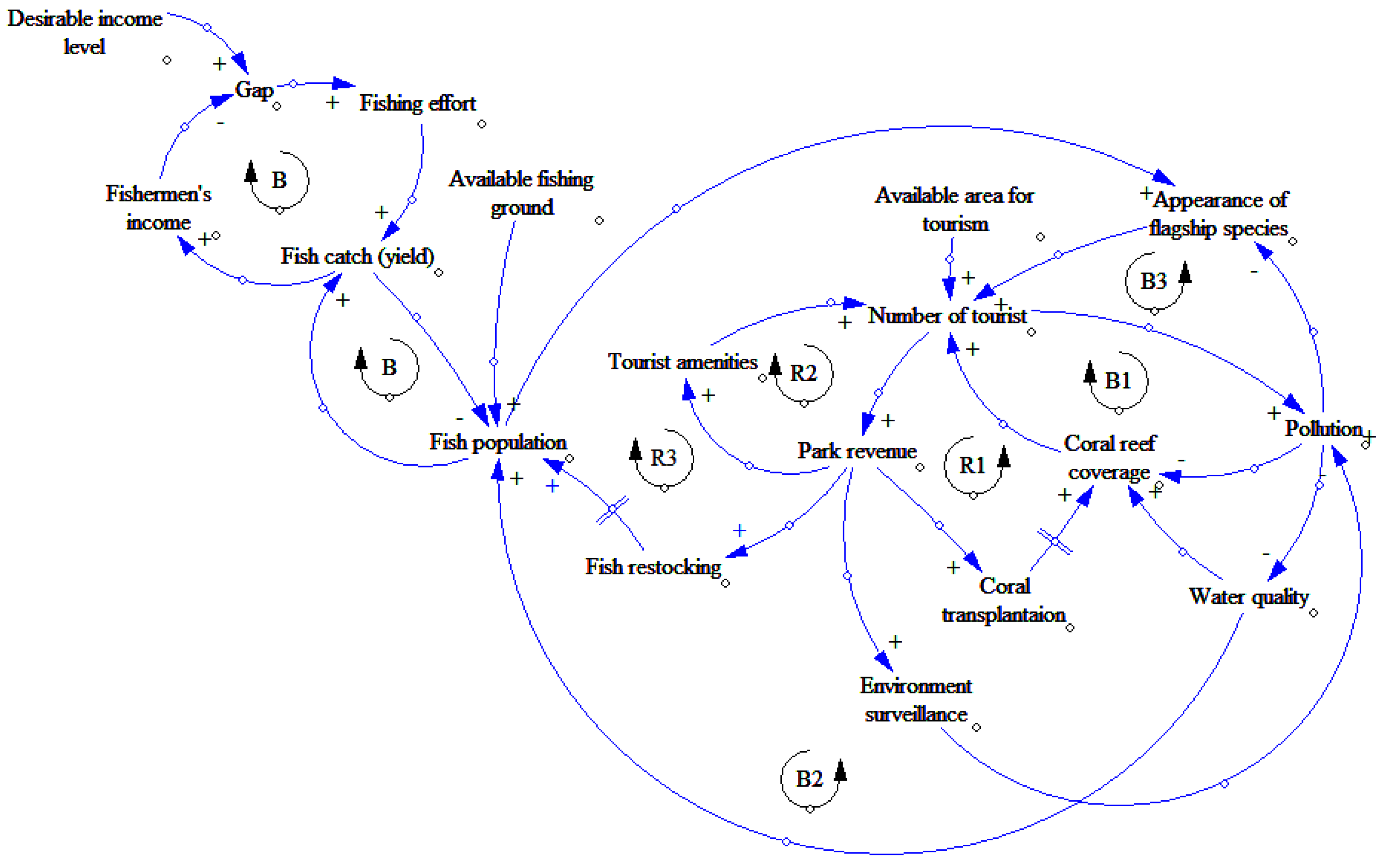

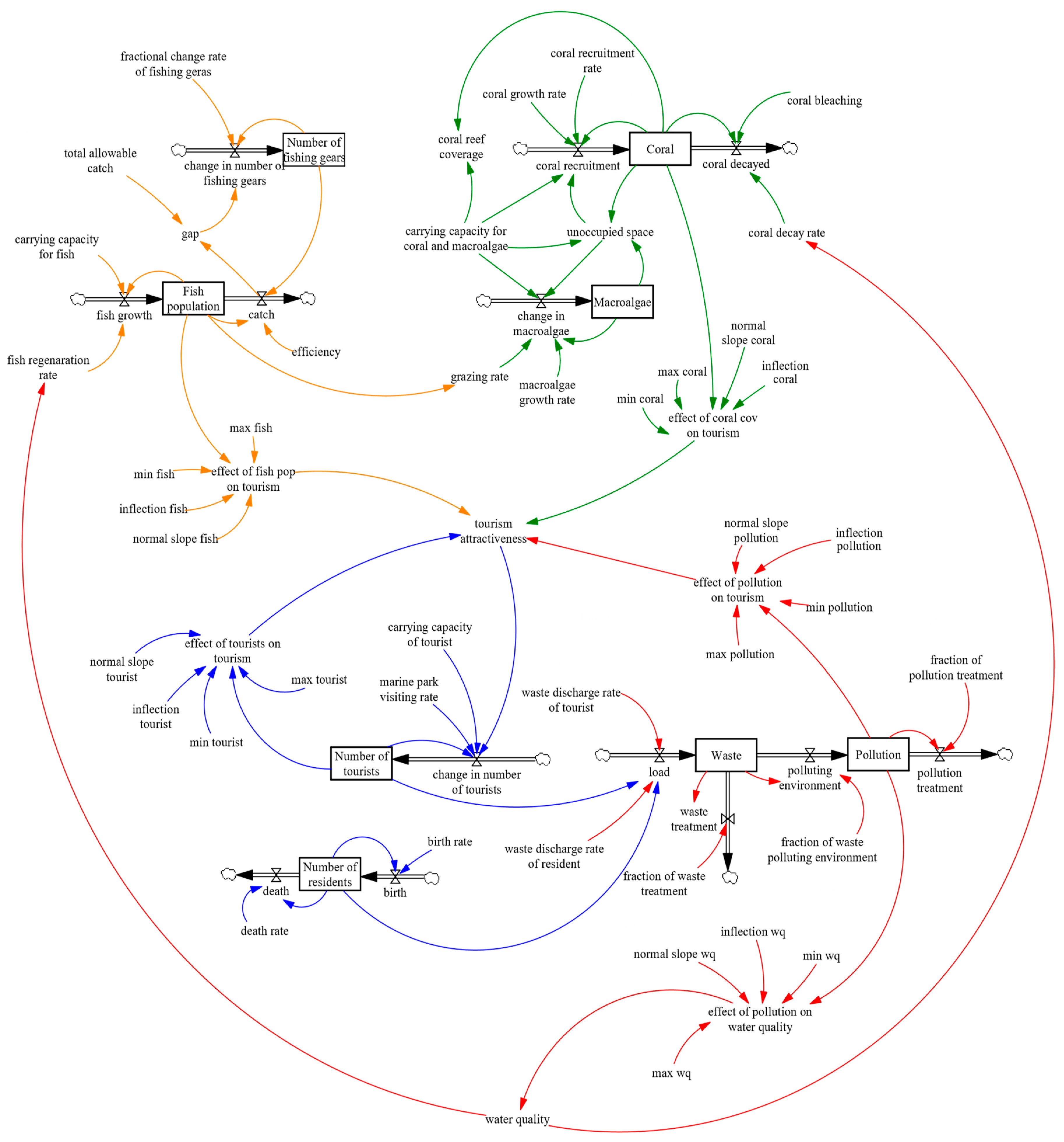


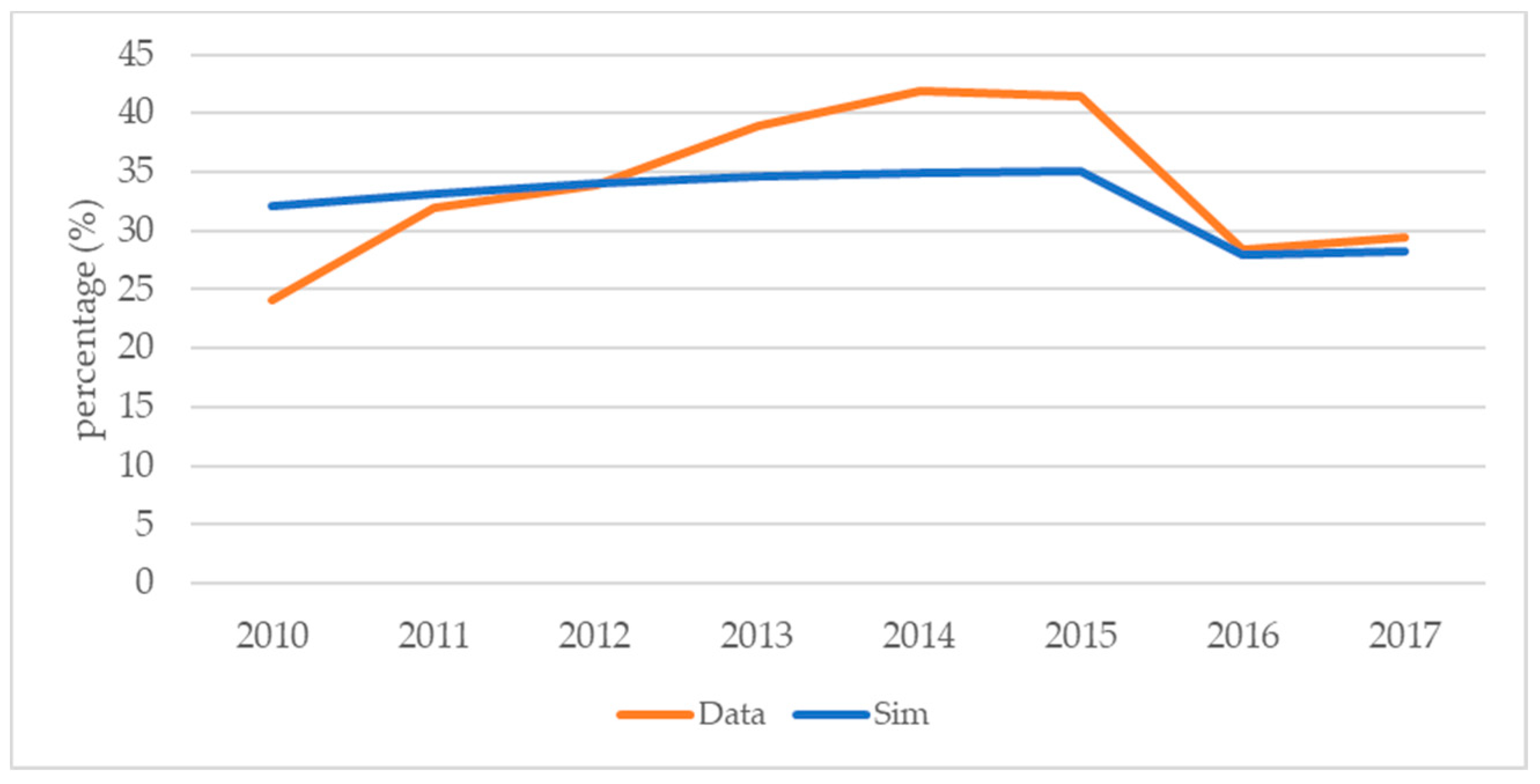


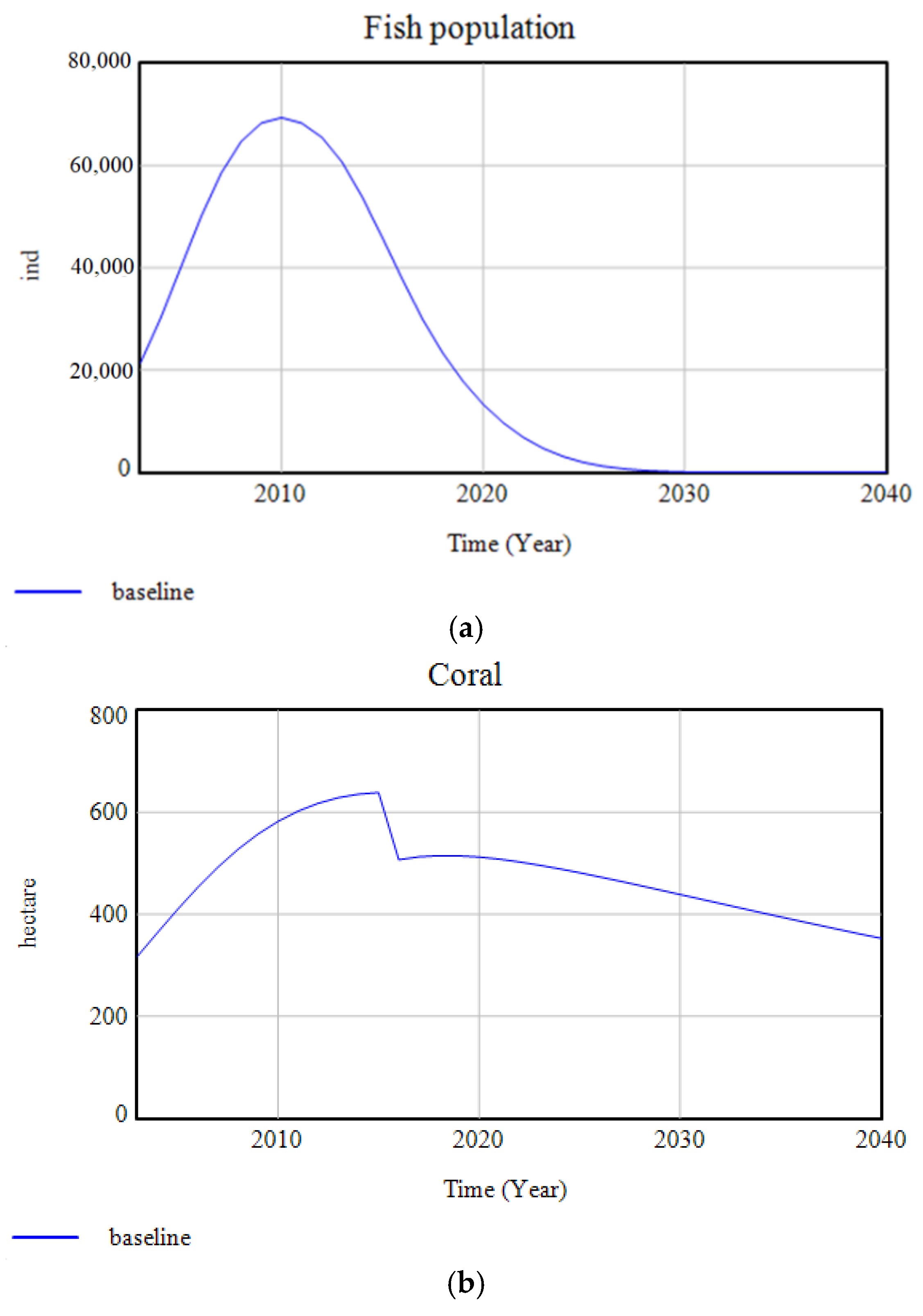
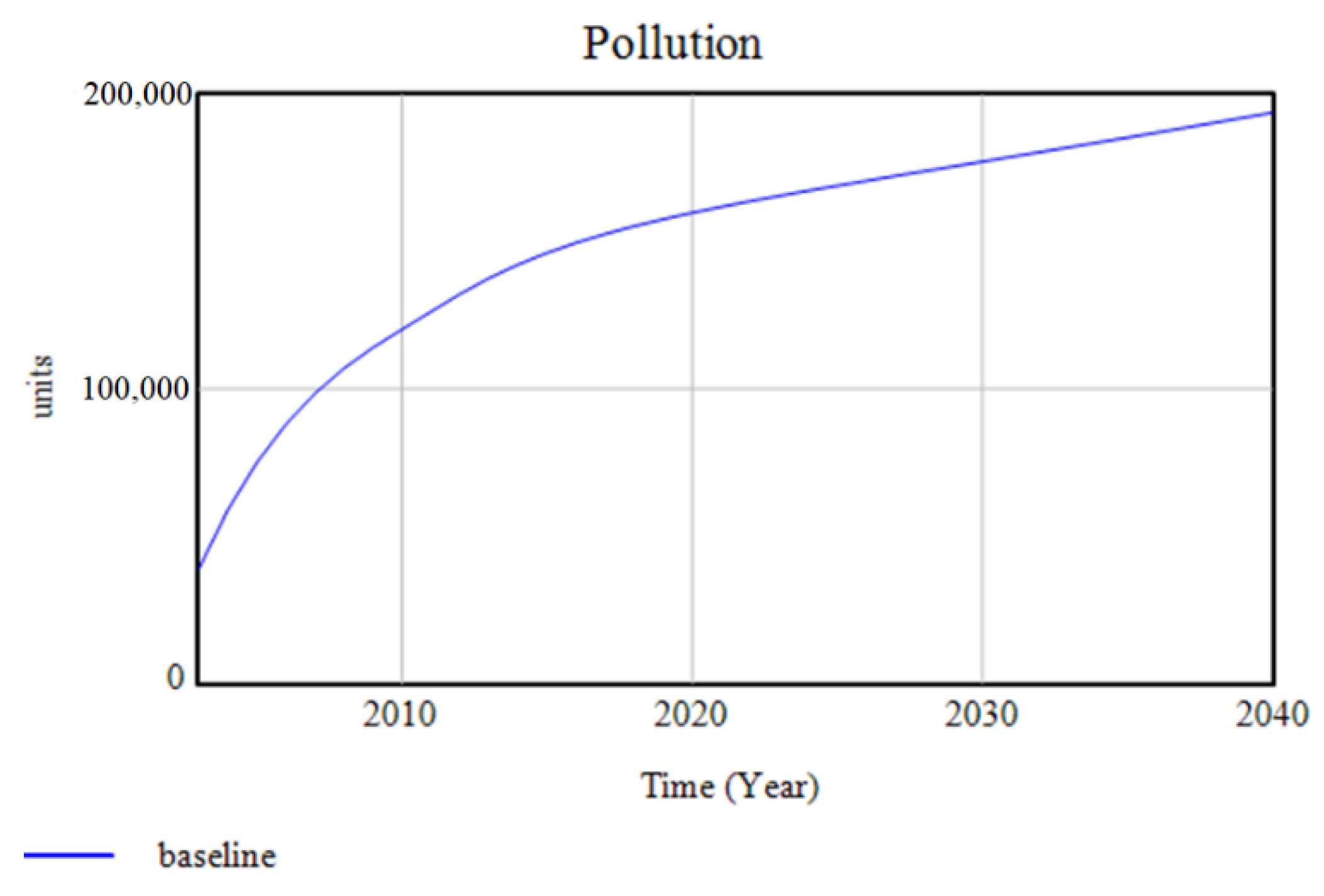

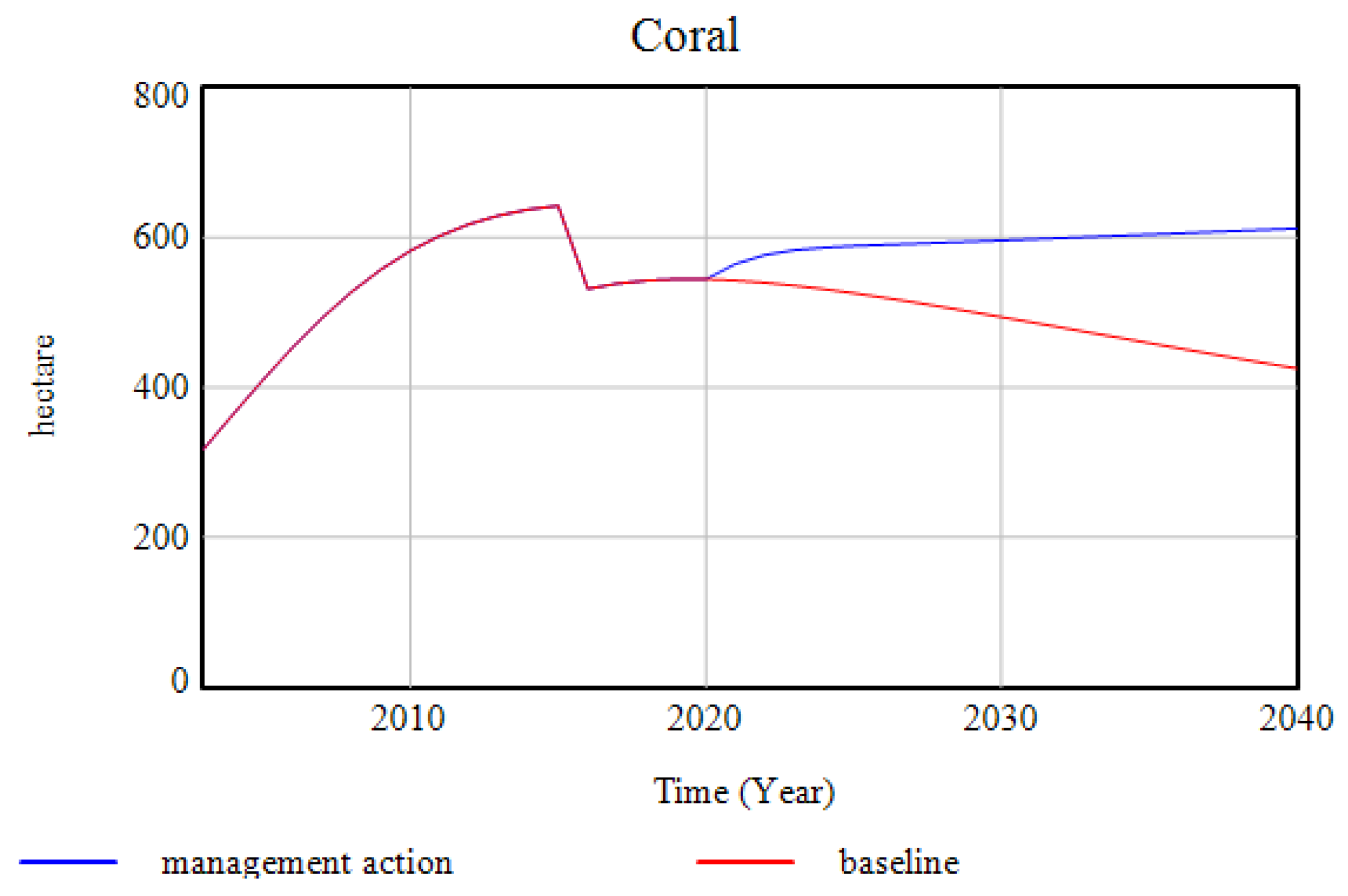
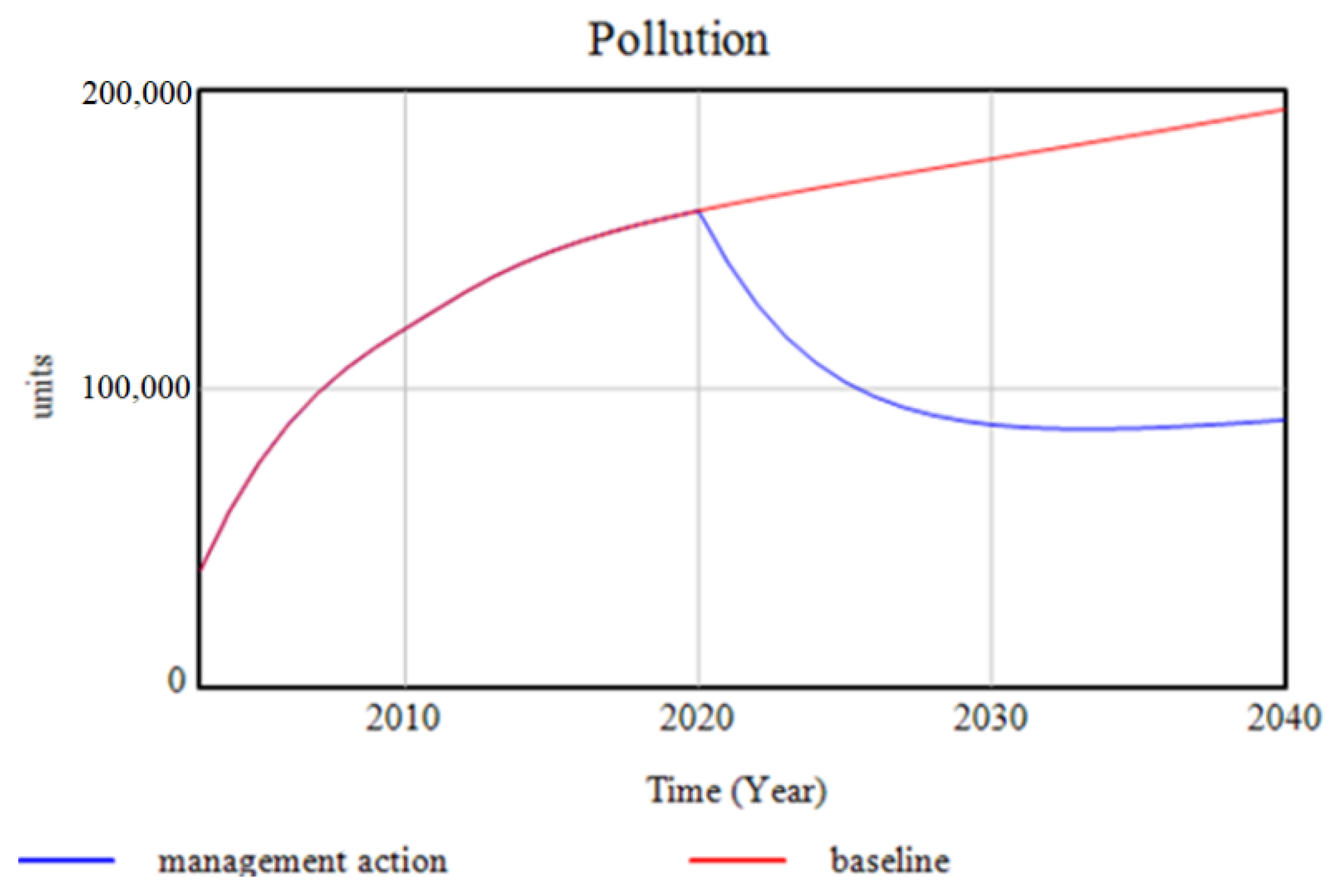
| Variables | a | b | c | d | e | f | g | h | i | j | k | l | m | n | o | p | AS | % |
|---|---|---|---|---|---|---|---|---|---|---|---|---|---|---|---|---|---|---|
| a. Fish population | 0 | 1 | 0 | 0 | 0 | 0 | 0 | 1 | 0 | 0 | 0 | 0 | 0 | 0 | 0 | 2 | 67 | |
| b. Available fishing ground | 1 | 0 | 0 | 0 | 0 | 0 | 0 | 0 | 0 | 0 | 0 | 0 | 0 | 0 | 0 | 1 | 33 | |
| c. Fish catch | 1 | 0 | 1 | 0 | 0 | 0 | 0 | 0 | 0 | 0 | 0 | 0 | 0 | 0 | 0 | 2 | 67 | |
| d. Fishermen’s income | 0 | 0 | 0 | 1 | 0 | 0 | 0 | 0 | 0 | 0 | 0 | 0 | 0 | 0 | 0 | 1 | 33 | |
| e. Fishing effort | 0 | 0 | 1 | 0 | 0 | 0 | 0 | 0 | 0 | 0 | 0 | 0 | 0 | 0 | 0 | 1 | 33 | |
| f. Coral reef coverage | 0 | 0 | 0 | 0 | 0 | 0 | 1 | 0 | 0 | 0 | 0 | 0 | 0 | 0 | 0 | 1 | 33 | |
| g. Water quality | 1 | 0 | 0 | 0 | 0 | 1 | 0 | 0 | 0 | 0 | 0 | 0 | 0 | 0 | 0 | 2 | 67 | |
| h. Number of tourists | 0 | 0 | 0 | 0 | 0 | 0 | 0 | 0 | 1 | 0 | 0 | 1 | 0 | 0 | 0 | 2 | 67 | |
| i. Appearance of flagship species | 0 | 0 | 0 | 0 | 0 | 0 | 0 | 1 | 0 | 0 | 0 | 0 | 0 | 0 | 0 | 1 | 33 | |
| j. Pollution | 0 | 0 | 0 | 0 | 0 | 1 | 1 | 0 | 1 | 0 | 0 | 0 | 0 | 0 | 0 | 3 | 100 | |
| k. Available area for tourism | 0 | 0 | 0 | 0 | 0 | 0 | 0 | 1 | 0 | 0 | 0 | 0 | 0 | 0 | 0 | 1 | 33 | |
| l. Tourist amenities | 0 | 0 | 0 | 0 | 0 | 0 | 0 | 1 | 0 | 0 | 0 | 0 | 0 | 0 | 0 | 1 | 33 | |
| m. Park revenue | 0 | 0 | 0 | 0 | 0 | 0 | 0 | 0 | 0 | 0 | 0 | 1 | 1 | 1 | 0 | 3 | 100 | |
| n. Coral transplantation | 0 | 0 | 0 | 0 | 0 | 1 | 0 | 0 | 0 | 0 | 0 | 0 | 0 | 0 | 0 | 1 | 33 | |
| o. Environment surveillance | 0 | 0 | 0 | 0 | 0 | 0 | 0 | 0 | 0 | 1 | 0 | 0 | 0 | 0 | 0 | 1 | 33 | |
| p. Number of residents | 0 | 0 | 0 | 0 | 0 | 0 | 0 | 0 | 0 | 1 | 0 | 0 | 0 | 0 | 0 | 1 | 33 | |
| PS | 3 | 0 | 2 | 1 | 1 | 3 | 1 | 4 | 2 | 3 | 0 | 1 | 1 | 1 | 1 | 0 | ||
| % | 75 | 0 | 50 | 25 | 25 | 75 | 25 | 100 | 50 | 75 | 0 | 25 | 25 | 25 | 25 | 0 | ||
| Year | Fish Catch (Ton) | Fishermen | Fishing Vessels | Fishing Gears |
|---|---|---|---|---|
| 2003 | 15,871.0 | 1726 | 1070 | 6962 |
| 2004 | 32,963.5 | 1727 | 1146 | 7191 |
| 2005 | 66,979.2 | 5305 | 1354 | 7329 |
| 2006 | 49,215.4 | 611 | 1430 | 12,775 |
| 2007 | 55,296.0 | 879 | 866 | 12,785 |
| 2008 | 50,101.5 | 658 | 1205 | 12,835 |
| 2009 | 43,632.5 | 658 | 1139 | 5232 |
| 2010 | 21,086.0 | 983 | 829 | 5182 |
| 2011 | 30,955.5 | 1032 | 881 | 2255 |
| 2012 | 32,377.9 | 1032 | 1137 | 2148 |
| 2013 | 34,813.8 | 1347 | 865 | 2068 |
| 2014 | 32,386.2 | 774 | 667 | 1039 |
| 2015 | 22,720.3 | 759 | 686 | 1003 |
| 2016 | 26,604.6 | 820 | 557 | 879 |
| 2017 | 25,472.2 | 718 | 497 | 698 |
| (a) | |||
| Fishing Vessels | Fishing Gears | Fishermen | |
| Multiple R | 0.968696212 | 0.956663131 | 0.966456648 |
| R Square | 0.938 | 0.915 | 0.934 |
| Adjusted R Square | 0.836 | 0.809 | 0.831 |
| Standard Error | 11.694 | 6.001 | 13.218 |
| (b) | |||
| Fishing Gears’ Model | Coefficient | Standard Error | t Stat |
| XtCPUEt | −0.0001 | 0.00008 | −1.299 |
| CPUEt | 2.1909 | 0.60017 | 3.65 |
| CPUEt2 | −0.0365 | 0.01953 | −1.866 |
| RMSPE | Theil’s Inequality Statistics | ||
|---|---|---|---|
| Bias | Unequal Variance | Unequal Covariance | |
| 0.67 | 0.3 | 0.0 | 0.7 |
| RMSPE | Theil’s Inequality Statistics | ||
|---|---|---|---|
| Bias | Unequal Variance | Unequal Covariance | |
| 0.15 | 0.1 | 0.5 | 0.4 |
| Key Variables | Parameters | Minimum | Base | Maximum |
|---|---|---|---|---|
| Fish population | Total allowable catch | 50,000 | 90,000 | 150,000 |
| Coral | Coral growth rate | 0.1 | 0.2 | 0.9 |
| Coral recruitment rate | 0.005 | 0.01 | 0.05 | |
| Number of tourists | Tourism growth rate | 0.01 | 0.11 | 0.5 |
| Pollution | Fraction of waste polluting | 0.1 | 0.8 | 0.9 |
| Fraction of pollution treatment | 0.1 | 0.25 | 0.9 |
| Year | Polluting (a) | Treatment (b) | (b − a) |
|---|---|---|---|
| 2020 | 21,034 | 9978 | 18,944 |
| 2021 | 19,947 | 35,628 | 15,681 |
| 2022 | 19,673 | 32,108 | 12,435 |
| 2023 | 19,696 | 29,347 | 9652 |
| 2024 | 19,826 | 27,219 | 7392 |
| 2025 | 19,997 | 25,597 | 5599 |
| 2026 | 20,184 | 24,374 | 4190 |
| 2027 | 20,378 | 23,466 | 3088 |
| 2028 | 20,575 | 22,803 | 2227 |
| 2029 | 20,776 | 22,331 | 1555 |
| 2030 | 20,978 | 22,008 | 1030 |
| 2031 | 21,182 | 21,802 | 620 |
| 2032 | 21,389 | 21,688 | 299 |
| 2033 | 21,597 | 21,645 | 48 |
| 2034 | 21,808 | 21,658 | −150 |
| 2035 | 22,020 | 21,715 | −305 |
| 2036 | 22,235 | 21,807 | −428 |
| 2037 | 22,451 | 21,926 | −526 |
| 2038 | 22,670 | 22,067 | −603 |
| 2039 | 22,891 | 22,226 | −666 |
| 2040 | 23,114 | 22,398 | −716 |
| Average | 21,163 | 24,942 |
© 2019 by the authors. Licensee MDPI, Basel, Switzerland. This article is an open access article distributed under the terms and conditions of the Creative Commons Attribution (CC BY) license (http://creativecommons.org/licenses/by/4.0/).
Share and Cite
Nugroho, S.; Uehara, T.; Herwangi, Y. Interpreting Daly’s Sustainability Criteria for Assessing the Sustainability of Marine Protected Areas: A System Dynamics Approach. Sustainability 2019, 11, 4609. https://doi.org/10.3390/su11174609
Nugroho S, Uehara T, Herwangi Y. Interpreting Daly’s Sustainability Criteria for Assessing the Sustainability of Marine Protected Areas: A System Dynamics Approach. Sustainability. 2019; 11(17):4609. https://doi.org/10.3390/su11174609
Chicago/Turabian StyleNugroho, Supradianto, Takuro Uehara, and Yori Herwangi. 2019. "Interpreting Daly’s Sustainability Criteria for Assessing the Sustainability of Marine Protected Areas: A System Dynamics Approach" Sustainability 11, no. 17: 4609. https://doi.org/10.3390/su11174609
APA StyleNugroho, S., Uehara, T., & Herwangi, Y. (2019). Interpreting Daly’s Sustainability Criteria for Assessing the Sustainability of Marine Protected Areas: A System Dynamics Approach. Sustainability, 11(17), 4609. https://doi.org/10.3390/su11174609






